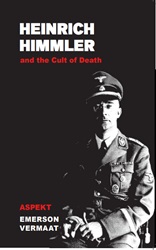Date of appearance: 16 January 2024
ISBN: 9789464871227
NUR: 680
Price 29,95 Euros
414 pages
Publisher
Uitgeverij Aspekt
Amersfoortsestrraat 27
3769 AD Soesterberg
Tel. 0031 (0)346 35 38 95
e-mail: info@uitgeverijaspekt.nl
www.uitgeverijaspekt.nl

Heinrich Himmler, one of the most infamous mass murders of all time, was originally from a conservative Catholic family in Bavaria. Later he would break away from the church.
Himmler and his SS are responsible for the murders of 6 million Jews. It was in the presence of Himmler himself that Hitller said on 18 December 1941 that the "the Jewish Question"can (only) be solved "by annihilating them as partizans," ("als Partizanen auszurotten.")
The Allied Forces knew more about this so-called "Holocaust" or "Shoa" than they cared to admit, since the British had broken the SS-codes. Himmler was heavily involved in the state-of-affairs of the Netherlands and Belgium. However, he clashed with Nazi collaborator and leader of the Dutch "National Socialist Movement" (NSB) Anton Mussert and several Flemish collaborators. They, unlike Himmler, did not wish to see the Netherlands and Belgium completely immersed in the Third Reich. An often overlooked aspect of the "Reichsführer-SS" is his fascination with Eastern religions and Islam. Astrology and the occult appealed to him as well.
What fascinated Himmler about Islam was the contempt for death the Islamic warriors showed when they marched die as martyrs. Himmler's best friend was Haj Amin Al-Husseini, the Grand Mufti of Jerusalem. Towards the end of the war, Himmler tried to get into good graces with the Allied Forces. He even met, in secret, with a spokesperson of the World Jewish Congress.
Haj Amin Al-Husseini's visit to Auschwitz
Dutch Auschwitz survivor Ernst Verduin claims he saw the Grand Mufti of Jerusalem paying a visit to Auschwitz-Monowitz in June or July1944. The author had a long interview with him on 29 February 2012, which was published in my books on Auschwitz (see pp. 145-147) and Eichmann (see pp. 206, 213, 214). There is no reason at all to doubt this credible witness, since it was a SS-man in Monowitz told him so. But in his book Rivalen in het Beloofde Land. Een geschiedenis van Joden en Palestijnen (2023), Dutch historian Jan-Auwke Diepenhorst doubts that such a visit took place, although he mentions my 2012 book on Eichmann. (See pp. 147, 148, 499, 527), but fails to mention Ernst Verduin and my 2013 book on Auschwitz. Nor does he refer to the authoritative study of Lukasz Hirzchowicz, The Third Reich and the Arab East published in 1966.
It is also absolutely certain that some of the Mufti’s associates visited the the notorious concentation camp of Sachsenhausen and that there was a special training course for radical Muslims who wanted to export Nazi methods of annihilating Jews to the Middle East and Palestine. One of these fanatics was even nicknamed "the Heydrich of the Middle East." This is what Eichmann himself admitted at the Eichmann Trial in Jerusalem when he said “I do not want to call it a course.” (See, inter alia, Israeli Public Prosecutor Gideon Hausner.)
Contents
Foreword by Perry Pierik
Accountability
1. Heinrich Himmler: from Adolescent in Baravia to Mass Murderer
2. The SS as a Pseudo-Religious Order of Death
3 . Himmler’s Confrontation with Church and Christianity
4. Himmler’s Remarkable Interest in Occultism, Buddhism and Hinduism
5. Himmler, Haj Amin Al-Husseini and Islam: “Islam is a practical and
sympathetic religion”
6. Himmler – The First Holocaust Denier: “We will never speak publicly
about it”
7. The role of Himmler and the SS in the Netherlands and Belgium
Footnotes
Literature
SS-Ranks
Positive review second Dutch edition (2023)
NBD Biblion (libraries), 12 April 2023.
"Deze eerste Nederlandse biografie van Himmler, gebaseerd op nieuw
materiaal, voorziet in een lacune. De goed onderbouwde studie, waarin
vooral in het eerste en de twee laatste hoofdstukken in druk maken, geeft
een uitstekend beeld van de mens die Himmler was en zijn rol in de
oorlog.” ”Vrijwel ongewijzigde herdruk."